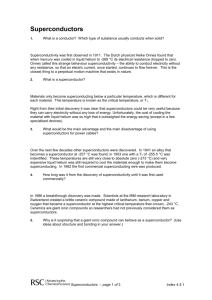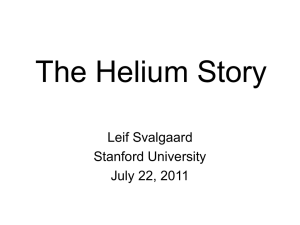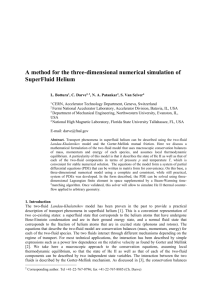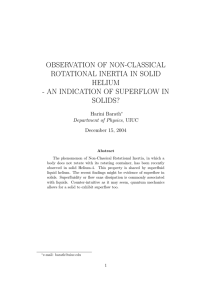spin3
advertisement
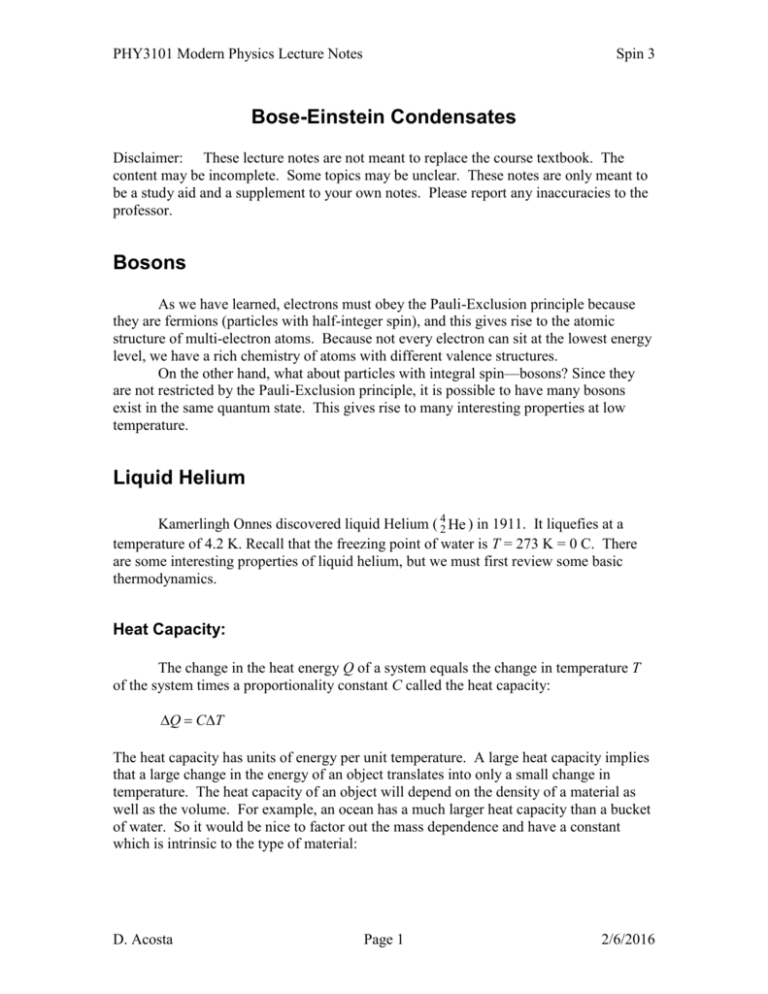
PHY3101 Modern Physics Lecture Notes Spin 3 Bose-Einstein Condensates Disclaimer: These lecture notes are not meant to replace the course textbook. The content may be incomplete. Some topics may be unclear. These notes are only meant to be a study aid and a supplement to your own notes. Please report any inaccuracies to the professor. Bosons As we have learned, electrons must obey the Pauli-Exclusion principle because they are fermions (particles with half-integer spin), and this gives rise to the atomic structure of multi-electron atoms. Because not every electron can sit at the lowest energy level, we have a rich chemistry of atoms with different valence structures. On the other hand, what about particles with integral spin—bosons? Since they are not restricted by the Pauli-Exclusion principle, it is possible to have many bosons exist in the same quantum state. This gives rise to many interesting properties at low temperature. Liquid Helium Kamerlingh Onnes discovered liquid Helium ( 42 He ) in 1911. It liquefies at a temperature of 4.2 K. Recall that the freezing point of water is T = 273 K = 0 C. There are some interesting properties of liquid helium, but we must first review some basic thermodynamics. Heat Capacity: The change in the heat energy Q of a system equals the change in temperature T of the system times a proportionality constant C called the heat capacity: Q CT The heat capacity has units of energy per unit temperature. A large heat capacity implies that a large change in the energy of an object translates into only a small change in temperature. The heat capacity of an object will depend on the density of a material as well as the volume. For example, an ocean has a much larger heat capacity than a bucket of water. So it would be nice to factor out the mass dependence and have a constant which is intrinsic to the type of material: D. Acosta Page 1 2/6/2016 PHY3101 Modern Physics Lecture Notes Spin 3 Specific Heat: The specific heat c is defined by the relation: Q c m T C . It has the dimensions of energy per unit temperature per m unit mass. It is approximately constant for similar materials of different volumes. In other words, c Specific Heat of Liquid Helium A curve plotting the specific heat of liquid helium as a function of temperature is shown below: The curve resembles the greek letter , and is thus referred to as the “Lambda Point” of liquid helium. It was discovered in 1932 by Keesom & Clausius, and the critical temperature occurs at T = 2.17 K. Note that the specific heat is discontinuous at the critical temperature, and jumps to a large value. This implies a large heat capacity of the liquid, which means that it can absorb a large amount of energy for only a small change in temperature. This is reminiscent of the transition of ice to water, in which the temperature remains constant as energy is absorbed to melt the ice. This is known as a phase transition, and indeed liquid helium is undergoing a phase transition at 2.17 K. But a transition into what? Superfluids Liquid helium below the critical temperature exhibits some remarkable properties. First of all, one observes that above the transition temperature liquid helium boils vigorously, but below it the liquid is absolutely calm. The first phase is referred to as the normal phase, or liquid helium I; and the second phase below the critical temperature is referred to as the superfluid phase, or liquid helium II. The reason that the second phase is referred to as a superfluid is that it exhibits very little viscosity (resistance to flow). Liquid helium II has a high rate of capillary D. Acosta Page 2 2/6/2016 PHY3101 Modern Physics Lecture Notes Spin 3 flow, and a thin film can crawl up the sides of a container. Imagine pouring a Coke into a glass and watching it flow up and over the rim of the glass! Two-Fluid Model of Liquid Helium The viscosity of Helium II increases dramatically as the temperature goes to zero. A model of the behavior of the liquid is that it contains two components: a normal phase component, and a superfluid component. As the temperature decreases, the superfluid fraction increases: FT I 1 G J HT K 3/ 2 f super C Another interesting phenomenon associated with liquid Helium II is that a new form of wave transmission is possible. In ordinary matter, pressure waves in the material manifest themselves as sound. This is an oscillation of the density of the material. In a superfluid, temperature waves are also possible. Normally heat diffuses into a material without any oscillation. Superfluids are perfect heat conductors, so oscillations in the heat energy are possible. This type of wave is referred to as Second Sound. The propagation velocity is about 10 times slower than ordinary sound waves. Bose Condensation The key to the bizarre behavior of superfluids is that the constituent atoms are bosons. 42 He is a boson. The ground state electron configuration is 1s2 , and thus has no net angular momentum or spin. The nucleus contains 2 protons and 2 neutrons, and as we shall see has a shell structure similar to that of the electrons. Thus, there is no net angular momentum or spin in the nucleus as well. With zero spin, a 42 He atom is a boson and does not obey the Pauli-Exclusion principle. Many atoms can exist in the same quantum mechanical state, even 1026 atoms! Thus, a macroscopic sample of liquid helium may have all atoms in the ground state. We refer to this as “Bose Condensation” into the ground state. The fluid acts coherently (all atoms have the same motion). With all atoms in the ground state, they are not easily excited into higher energy levels. The sample cannot dissipate energy, so there is little resistance or viscosity. However, low temperatures are required so that the thermal energy (which otherwise would excite the atoms) is small. Another example of a Bose condensate is the laser, where all photons are in the same coherent state. D. Acosta Page 3 2/6/2016 PHY3101 Modern Physics Lecture Notes Liquid Spin 3 3 2 He Now consider 23 He , which is an isotope of helium with one less neutron. Although the electron configuration is the same as ordinary helium, a neutron is unpaired in spin. The entire atom thus has spin 1/2, and is a fermion. It must obey the PauliExclusion principle. So even though the mass is nearly the same as 42 He , and the electron configuration is the same, 23 He does not become a superfluid at T = 2.17 K. On the other hand, much later in 1971, Doug Osheroff, David Lee, and Robert Richardson demonstrated that 23 He becomes a superfluid at the very cold temperature of 2.7 mK (1000 times smaller than 42 He ). How is this possible? Two atoms of 23 He align themselves to give an overall spin of s = 1 and angular momentum l = 1. The paired system becomes a boson! Thus, liquid 23 He can become a superfluid, but only when two atoms perform a complicated dance and act as one particle. This paring is so weak that very low temperatures are required to keep thermal energy from breaking them up. The three co-discoverers received the Nobel prize in 1996. D. Acosta Page 4 2/6/2016 PHY3101 Modern Physics Lecture Notes Spin 3 Superconductivity For some materials, the resistivity drops exactly to zero at low temperatures. An electrical current can travel in a superconductor for many years without any loss. Present limits are greater than 106 years! The first superconductor was discovered by Kamerlingh Onnes in 1911: the element mercury (Hg). It has a critical temperature of TC = 4.2 K. The highest critical temperature for a pure element is 9.3K for the element Niobium (Nb). It is often used in wires for superconducting magnets. In recent years, however, enormous advances have been achieved with superconducting ceramics. For example YBa 2 Cu 3O7 was found to have a critical temperature of 93K in 1987. Since this temperature is above the boiling point of liquid nitrogen (77K), one does not need to use liquid helium as a coolant (which is much more expensive than liquid nitrogen). Thus, these High TC superconductors are a technological advance. The Holy Grail of this research would be to find a material which is a superconductor at room temperature! Meissner Effect In 1933 Meissner and Ochsenfeld discovered a property of superconductors now known as the Meissner Effect: the complete expulsion of magnetic flux from a superconductor. Screening currents develop which exactly cancel an external magnetic field. This effect might be reminiscent of Lenz’s Law in electromagnetism, whereby a current develops to oppose a changing magnetic field. The difference with superconductors is that the current develops to oppose a constant magnetic field. The Meissner effect allows a superconductor to levitate above a magnet without any applied energy. Someday, perhaps technology will allow for levitating trains based on this effect, perhaps incorporating High TC superconductors. BCS Theory A theory to explain normal superconductors (not the High TC superconductors) was developed by John Bardeen, Leon Cooper, and Robert Schriefer in 1957 (Nobel prize in 1972). In this theory, electrons in the metal (which are fermions) form pairs with s = 0 and l = 0 to become bosons, thus avoiding the Pauli-Exclusion Principle. These “Cooper Pairs” travel in resonance with lattice vibrations (phonons) in the solid. Because the pairs are all in the same ground state, they travel without energy dissipation. Thus, there is no resisitance. D. Acosta Page 5 2/6/2016

